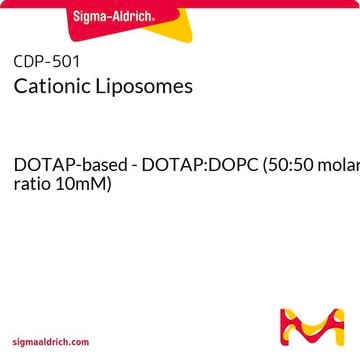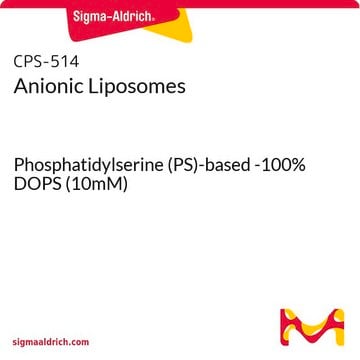Products may be shipped at a different temperature than the recommended long-term storage temperature. If the product quality is sensitive to short-term exposure to conditions other than the recommended long-term storage, it will be shipped on wet or dry-ice. If the product quality is NOT affected by short-term exposure to conditions other than the recommended long-term storage, it will be shipped at ambient temperature. As shipping routes are configured for minimum transit times, shipping at ambient temperature helps control shipping costs for our customers. For more information, please refer to the Storage and Transport Conditions document: https://www.sigmaaldrich.com/deepweb/assets/sigmaaldrich/marketing/global/documents/316/622/storage-transport-conditions-mk.pdf
L4395
Liposome Kit: Lipid mixtures for the preparation of liposomes
lyophilized powder
Sinônimo(s):
cholesterol, L-α-phosphatidylcholine and stearylamine kit
Selecione um tamanho
Selecione um tamanho
About This Item
Produtos recomendados
fonte biológica
egg yolk
Nível de qualidade
Formulário
lyophilized powder
composição
Cholesterol, 9 μmol/package
L-α-Phosphatidylcholine (egg yolk), 63 μmol/package
Stearylamine, 18 μmol/package
grupo funcional
carboxylic acid
Condições de expedição
ambient
temperatura de armazenamento
−20°C
Categorias relacionadas
Ações bioquímicas/fisiológicas
produto relacionado
Palavra indicadora
Danger
Frases de perigo
Declarações de precaução
Classificações de perigo
Aquatic Acute 1 - Aquatic Chronic 1 - Eye Dam. 1
Código de classe de armazenamento
11 - Combustible Solids
Classe de risco de água (WGK)
WGK 3
Ponto de fulgor (°F)
Not applicable
Ponto de fulgor (°C)
Not applicable
Escolha uma das versões mais recentes:
Certificados de análise (COA)
Não está vendo a versão correta?
Se precisar de uma versão específica, você pode procurar um certificado específico pelo número do lote ou da remessa.
Já possui este produto?
Encontre a documentação dos produtos que você adquiriu recentemente na biblioteca de documentos.
-
How is shipping temperature determined? And how is it related to the product storage temperature?
1 answer-
Helpful?
-
-
How can I determine the shelf life / expiration / retest date of this product?
1 answer-
If this product has an expiration or retest date, it will be shown on the Certificate of Analysis (COA, CofA). If there is no retest or expiration date listed on the product's COA, we do not have suitable stability data to determine a shelf life. For these products, the only date on the COA will be the release date; a retest, expiration, or use-by-date will not be displayed.
For all products, we recommend handling per defined conditions as printed in our product literature and website product descriptions. We recommend that products should be routinely inspected by customers to ensure they perform as expected.
For products without retest or expiration dates, our standard warranty of 1 year from the date of shipment is applicable.
For more information, please refer to the Product Dating Information document: https://www.sigmaaldrich.com/deepweb/assets/sigmaaldrich/marketing/global/documents/449/386/product-dating-information-mk.pdfHelpful?
-
-
What is the Department of Transportation shipping information for this product?
1 answer-
Transportation information can be found in Section 14 of the product's (M)SDS.To access the shipping information for this material, use the link on the product detail page for the product.
Helpful?
-
-
I'm thinking of purchasing Product L4395, Liposome Kit. Why would one use positive vs. negative liposomes?
1 answer-
Analogous to poly-L-lysine, one may need positively charged agents to deliver drugs to cells, hence positive liposomes.
Helpful?
-
-
I have purchased Product L4395, Liposome Kit. Is there a difference between positive and negative liposomes?
1 answer-
The choice is dependent upon what is being encapsulated and how it is being used. A good reference discussing this question is Ogiso, T., et al., Effect of positively and negatively charged liposomes on skin permeation of drugs. J. Drug Target, 9(1), 49-59 (2001).
Helpful?
-
-
How is Product L4395, Liposome Kit, used?
1 answer-
The Liposomes of a large multilamellar structure type are the most widely used. They can be prepared using Sigma liposome mixtures by concentrating an organic solvent solution of lipids to a thin film on the walls of a container such as by rotary evaporation or by drying in glass with a stream of nitrogen gas. Then, under appropriate conditions, an aqueous solution is added to the thin film and with agitation multilamellar vesicles should form spontaneously with little effort. Large or small unilamellar structured liposomes can also be prepared by varying procedure or conditions. Please see the product insert for Product No. L4031 (the link below) for a step by step protocol that will work for this product also.
Helpful?
-
-
How do I prepare the Product L4395, Liposome Kit liposomes?
1 answer-
Refer to the product information sheet (under Documents, above) for L4031 for preparation information.
Helpful?
-
Active Filters
Nossa equipe de cientistas tem experiência em todas as áreas de pesquisa, incluindo Life Sciences, ciência de materiais, síntese química, cromatografia, química analítica e muitas outras.
Entre em contato com a assistência técnica









